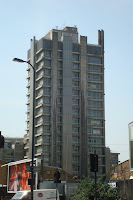The final project pieces will not be posted up here but I will reflect on them and the project as a whole none the less. I am pleased with the completion of the task. It was a great exercise in methods and processes and taught me alot about the simple act of timing, rendering and most importantly I feel project organisation.
The simpler the outcome got the happier I was as I feel I have produced an 'honest' result to my brief. It may seem that not a great deal was achieved in terms of animation but this project iwas I feel very large in terms of management and preparation..
At times the proposal was not central to my thinking and this slowed the project down as I forgot the main aim of the whole thing. A shame considering the writing of the proposal was a very useful exercise and the part that although initially struggling with, I actuallly enjoyed immensely.
It is very difficult to clearly state why you want to do something and then how!
Stylistically the result is somewhere in the middle. Interestingly minimal but at the same time too conservative in approach. To me though it is still an 'animatic' or test piece, a working out of ideas in one technology that can then be followed through with more imagination.
It has definately helped me with 3D software skills, not in terms of modelling, texturing etc but in terms of new approaches to form generation and dealing with time and sequence, areas that I will try to incorporate into wider architectural visualisation.
I have not really had the time to see this through to an installation or interactive outcome, but this is the next step. I am content to realise this. This I feel is the major learning to come from the last term, that nothing comes easy in this field, and that only through hard work and alot of hours do results show themselves. I struggled at many times to get to the next stage mainly because working with computers can lack a sense of scale and immediacy that I get from other mediums.
I have pushed myself to do thorough research and the hidden benefit of such projects is all the little bits of new information that you pick up along the way, even if they dont immediately inform your work. I now know about stereoscopy, the history of the phone exchange, how to make your own dialtones and obviously alot more about a building in Vauxhall.
It is a shame that this has to end now as I only just feel that the project has got to that brilliant stage when it becomes malleable and decisions feel intuitive. Obviously I would do things differently if going over again, but I feel that I have got alot out of the system and can now move on with a clearer focus.
Although not a convert to purely deterministic approaches to projects I have noved away from trying to pre-judge outcomes and getting confused with simply trying to visualise an 'image' that I feel may look impressive.
The next project that I undertake will be more interesting as a result I'm sure.
























